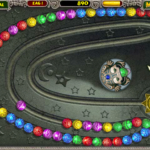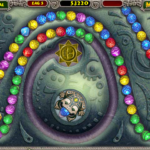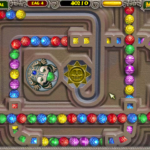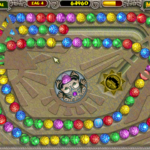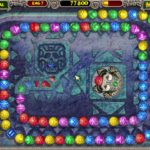Everyday Zuma
The title “Everyday Shooter” can be taken two ways. It can mean a shooter that’s ordinary, the sort of dime-a-dozen thing that you see every day, or it can mean something that you play on a daily basis. And that’s got me thinking: both Everyday Shooter and Zuma are built for everyday play in the second sense. They both seem to want players to engage them casually but over an extended period of time. But they encourage this in different ways.
There are common elements, sure. Both games are skill-based, which rewards frequent play as the way to keep your skills intact. And both games discourage extended play within a single session by providing limited lives, and making the player start over when they’re gone. Once I’ve reached or even extended the apex of my achievement, I don’t really want to get kicked back to the very beginning — at least, not until I’ve taken a break and cleared my head. Where they differ is in their treatment of permanent progress. In Zuma, progress plateaus. It lets you skip over chambers you’ve cleared, but progress within a chamber is transient. If, like me, you play the ninth chamber repeatedly without reaching its end, those sessions are effectively wasted, except insofar as they provide practice that increases your skill. Everyday Shooter, on the other hand, does not let you skip levels, but at the same time, no session is wasted. As long as you get at least one point per game, those points build up over time and eventually let you buy additional starting lives.
Consequently, Everyday Shooter has an implicit promise that you will eventually beat the game if you keep playing it for long enough, even if you have to buy hundreds of lives to do so. (I said before that the cost of life increased exponentially, but in fact it seems to be capped at 20000. I’m currently earning about 3000 per session, which means I’d get a life per week if I play the game once daily.) Zuma makes no such implicit promise, but has a high enough luck factor to offer players hope anyway — sometimes you catch a break and the game delivers just the right sequence of colors to let you rack up a massive Chain Bonus and beat the level easily. The difference is a bit like saving up your spare change versus playing the lottery. Or, to put it another way, continuous versus variable reinforcement. So, even though Everyday Shooter in some sense gives the player more motivation to keep playing every day, the motivation in Zuma is of a much more insidious and addictive sort. (And I don’t mean “addictive” in the positive sense used in game advertising.)
 Comments(1)
Comments(1)